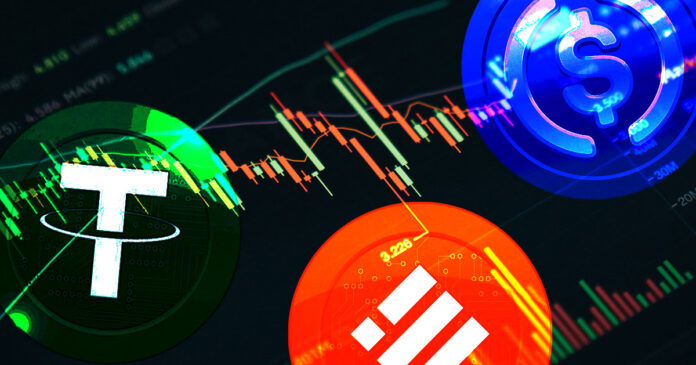
Gradually, alongside the cryptocurrency industry, stablecoins are growing in strength and popularity. Their growth results from the stability they offer against cryptocurrency volatility.
At the moment, USDT remains the largest stablecoin by market cap, as USDC, Binance USD, and DAI make up the top 4.
Prominent stablecoins after FTX collapse
The entirety of the stablecoin sector has a market cap of $138 billion, according to CoinMarketCap. The big four stablecoins contribute more than $130 billion to the figure, dominating the stablecoin market. Despite their growth and popularity, only a minimal amount of stablecoins are on cryptocurrency exchanges.
Presently, about 37 billion stablecoins are held in reserves of cryptocurrency exchanges. Binance is the highest contributor to this figure, with about $24 billion in stablecoins in its reserve. Coinbase has more than $973 million, Huobi $709 million, Bitfinex $145 million, Gemini 98 million, and Gate.io $78 million.

Due to market uncertainty and low trust in centralized exchanges after the collapse of FTX, about 3.93 billion stablecoins have left exchanges in the last 30 days.
Despite the prevailing crypto winter, USDT has enjoyed more of a stable presence in the reserve of cryptocurrency exchange. Since August 2022, USDT has largely stayed flat at $18 billion in the reserve of cryptocurrency exchanges.

USDC, on the other hand, has enjoyed some growth while trying to curb USDT’s dominance in the stablecoin market. Since the collapse of FTX in early November 2022, the amount of USDC in the reserve of cryptocurrency exchanges doubled to $5 billion.

However, the resilience the stablecoin sector has been enjoying since the collapse of Terra Algorithm stablecoin UST is somewhat under threat. Following the announcement of Huobi Global to delist the HUSD stablecoin, the token has suffered a massive decline.
Shortly after the announcement, the stablecoin fell 72% off its dollar peg, and now HUSD is trading at 13 cents. In a sharp dip, the amount of HUSD in cryptocurrency exchange reserves is about to surpass its all-time low of $65 million.

Stablecoin reserve in centralized exchanges
Following the collapse of FTX, investors began to doubt the reliability of Centralized exchanges. As of January 12, Binance recorded about $5.202 billion outflow of stablecoin since the collapse of FTX.

Likewise, within two months after the demise of FTX, Coinbase Pro saw a net outflow of $690 million, Huobi $277 million, Bitfinex $125 million, Gemini $398 million, and Gate.io $42 million.
OKX, on the positive side, didn’t record a deficit; instead, the cryptocurrency exchange enjoyed a $43 million net inflow.

Within this period, cryptocurrency exchanges witnessed about $6.2 billion net outflow of stablecoin, with Binance suffering the most, according to Cryptoquant. However, the outflow cannot be considered significant since Binance held about $39.9 billion worth of stablecoin, according to its proof of reserve report from Nov. 10.
Exchanges like Binance and Crypto.com released proof-of-reserves with Mazars in November to establish users’ trust. Even so, the firms later faced backlash from the community as some argued that the report did not reveal the full reserve of the exchanges.
In a harsh consequence, Binance, within a day, witnessed a massive withdrawal of stablecoins that amounted to about $2.1 billion.
It’s apparent from the charts that users still have trust issues with centralized exchanges since stablecoin reserves continue to fall.
Credit: Source link






















 Bitcoin
Bitcoin  Ethereum
Ethereum  XRP
XRP  Tether
Tether  Solana
Solana  USDC
USDC  Dogecoin
Dogecoin  Cardano
Cardano  Lido Staked Ether
Lido Staked Ether  TRON
TRON  Wrapped Bitcoin
Wrapped Bitcoin  Wrapped stETH
Wrapped stETH  Chainlink
Chainlink  Avalanche
Avalanche  Sui
Sui  Stellar
Stellar  Litecoin
Litecoin  Shiba Inu
Shiba Inu  Toncoin
Toncoin  Hedera
Hedera  LEO Token
LEO Token  USDS
USDS  Hyperliquid
Hyperliquid  Polkadot
Polkadot  WETH
WETH  MANTRA
MANTRA  Bitcoin Cash
Bitcoin Cash  Ethena USDe
Ethena USDe  Bitget Token
Bitget Token  Wrapped eETH
Wrapped eETH  Uniswap
Uniswap  Monero
Monero  NEAR Protocol
NEAR Protocol  Pepe
Pepe  WhiteBIT Coin
WhiteBIT Coin  Aave
Aave  Ondo
Ondo  Bittensor
Bittensor  Aptos
Aptos  Internet Computer
Internet Computer  Dai
Dai  Official Trump
Official Trump  Ethereum Classic
Ethereum Classic  Tokenize Xchange
Tokenize Xchange  Mantle
Mantle  OKB
OKB  Gate
Gate  sUSDS
sUSDS  Coinbase Wrapped BTC
Coinbase Wrapped BTC 
